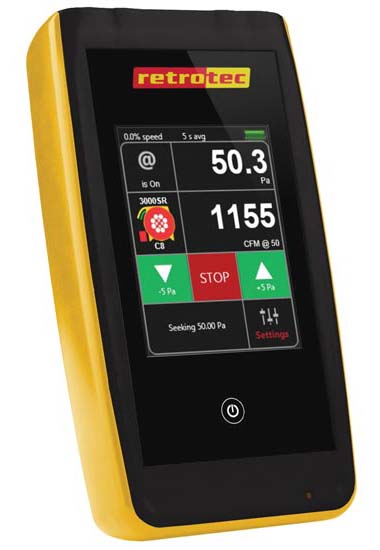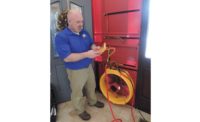“You honestly really can’t just shop your way into home performance.”
Good advice from Elena Chrimat, co-founder of Ideal Energy in Phoenix. Nevertheless, as attention to home HVAC performance increases, so does the potential for success in home performance contracting (HPC).
HVAC contracting and experience can serve as a good springboard into HPC work, but even currently successful contractors interested in HPC won’t necessarily have everything at the office or on the truck that will be required to do HPC work well.
Blower Doors & More
Asked for three pieces of equipment that an HVAC contractor might need to buy to get into HPC, Chrimat and fellow Building Performance Association board member Rob Minnick did have one predictable answer in common: a blower door.

AIRTIGHT: A blower door is essential equipment when moving to home performance work. This single-fan popup blower door includes a “cruise control” function to maintain a variety of speeds and operates under either 110V or 220V power. Photo courtesy of Energy Conservatory.
“This comes down to personal preference,” said Chrimat, “but we use Energy Conservatory because that was the brand we learned on 11 years ago. But both Retrotec and Energy Conservatory measure cfm and pressure, so it really comes down to preference at this point.”
Minnick, CEO of Minnick’s in Laurel, Maryland, did not mention brands for this fundamental component of home energy audits, but he stressed the importance of satisfaction with the level of support that will come after the purchase. Timely access to someone who can fix or replace a unit as needed can be key, and Minnick agreed that to some extent, you get the tech support you pay for.
As with shopping for most anything including other types of equipment mentioned here, the price out the door can fluctuate depending on the bells, whistles, and packages that might interest a buyer. For the most part, a single-fan blower door system might run between two and four thousand dollars.
If You Can’t Measure It, You’re Just Guessing
Shifting from moving the air to measuring air movement, flow hoods are another essential item for determining air volume coming through diffusers or registers.
Informal checks through the industry put a typical new flow hood at anywhere from $1,500 toward $3,500 or more, depending on variables.

COMBUSTION ANALYZERS: Contractors who have gotten by without one will need to invest for home performance contracting jobs. Usually a few to several hundred dollars, variables include number of sensors (CO, O2), runtime, the CO sensor’s range of measurement, and data transfer options.
The next piece of equipment is likely the most surprising among the items mentioned for this article: a combustion analyzer. Minnick recalled making a presentation to an audience of contractors when, based on his read of the room, he paused and asked everyone to put a hand up. Then he asked everyone who owned a combustion analyzer to lower their hand.
None of the hands went down.
Despite a combustion analyzer’s value in multiple situations including running a Manual J calculation, Minnick’s assessment is that many contractors “just weren’t taught that you need one.”
It would not be unusual to buy a new combustion analyzer for between $500 and $600. Variables and features affecting price may include number of sensors (CO, O2), runtime, the CO sensor’s range of measurement, and low- or high-tech options for transferring reporting data.
Insulation and Infrared
Data transfer also comes into play when shopping for an infrared device, one of the HPC essentials that Chrimat mentioned.
Chrimat’s team uses FLIR infrared cameras. The company’s website offers a free one-sheet on common infrared uses for an HVAC or home performance contractor. Its list includes (but is not limited to) spotting leaky ductwork joints, easily evaluating the performance of a radiant floor, and checking the condition of condenser coils.
Like the combustion analyzer, infrared devices can be standard equipment for HPC work but can also provide value and time savings in traditional HVAC work.
Using FLIR as a one-stop small sample for infrared equipment lines and pricing, its $349 thermal imaging tool is designed for energy audit work. The middle choice comes in at $699, highlighting its range of vision, detector sensitivity, and on-board memory.
Finally, the top of its trio is a leap, at $2,999. For this model, FLIR touts upgrades including superior resolution, a focus-free lens and simple navigation for ease of use, and Wi-Fi connectivity to allow for instant sharing and reporting.
An insulation machine is another investment for new HPC teams, unless they opt to subcontract that job elsewhere. Chrimat mentioned that Ideal Energy does it themselves and uses Krendl equipment.
That manufacturer divides its offerings into three categories, based on user and type of job: small DIY, medium professional, and large professional (cleverly, Krendl also sells vacuums).
Within the medium professional category alone, contractors have five options. Along with some typical budget tradeoffs, decisions affecting price include power source (gas, electric, or dual source), design variations like hopper capacity, and additional shredder/agitators.
Software Selection
While hardware might be the first thing potential HPC owners think of when it comes to mandatory purchases, software is where all that work and measuring start to transform into evaluations, recommendations, and conversations with customers.

WIRED OR WIRELESS: A gauge like this digital touchscreen manometer with Wi-Fi can work with associated analytical software to collect, export, and evaluate results. Photo courtesy of Retrotec.
Minnick had kind reviews for Energy Design Systems software. EDS does the expected load calculations, but Minnick likes its two-column format. Users run the data as is, he said, and the first column reflects performance in current conditions. Then, once a contractor inputs his plans based on those findings, the second column changes to reflect the anticipated performance.
“It’s the furnace that often gets way oversized for some reason,” Minnick said. At the end of the process, the two-column layout provides a useful, accessible graphic approach for talking with customers about audit results and potential improvements.
Chrimat uses software from OptiMiser. Users can choose to rely on the product not only for audit reports but for managing leads and scheduling work as well.
OptiMiser’s integrated building performance software package involves a one-time $500 setup fee and then $125 per month after that. The EDS Auditor software also uses a subscription model, costing $200 annually or $20 per month per user.
Beyond The Shopping Cart
Despite needing items like these and more for a proper setup, contractors looking to build a presence in home performance contracting don’t have to take a la carte approach to acquiring equipment.
“When we got into it in 2005, we partnered up with Comfort Institute,” Minnick recalled. His company invested in a Comfort Institute HPC package that amounted to a solid starter kit: not only “all the tools” but training and videotapes included, too.
Minnick mentioned TruTech Tools, which carries assorted options in all the basic HPC equipment categories. A vendor like that, he said, may have ready-to-go packages or could be open to piecing together a custom package based on a contractor’s situation that would avoid dealing with multiple vendors.
ROI and All The Fundamentals
Despite this article’s emphasis on essential and/or smart spending, some return on investment really is supposed to enter the picture eventually. But that only happens if customers pay for the work, and customers can’t pay for it unless the work is priced.
Sure, pricing the HVAC side may be familiar enough, but what about insulation? Duct sealing? Drywall, if necessary? Some areas require that “to sub or not to sub?” decision further up the decision tree.
(Talking about this reminds Minnick of one more piece of equipment: the anemometer, especially for kitchen ventilation. According to Minnick, the overall needs of HPC work recall the advice, “If you’ve taken the ‘V’ out of HVAC, get back into it.”)
“Pricing gets to be a challenge because you’ve never done it,” Minnick said. Which is why he always encourages HVAC contractors to seek out conference and training opportunities — anywhere HVAC and HPC professionals can actually compare notes and share experiences.
Finally, calling back Chrimat’s quote at the top of this article, even the best equipment won’t matter unless the contractor has a solid understanding of what they’re doing in this expanded field of energy efficiency combat.
One free resource (among others) for ACCA members is ACCA Standard 12, covering Home Evaluation & Performance Improvement. Beyond outlining proper processes for the essential HPC tasks, it gets into some equipment details as well, such as minimum spec details for thermometers for HPC use.
At the end of the day, the most profitable investment for HPC startups may involve time and attention before even starting to peruse those blower doors and nifty infrared tools.
“You really need to know what you’re doing in people’s homes, or you’ll have a serious potential to cause some damage,” Chrimat said. “I would say the first thing you can do is get a BPI Building Analyst Certification and ensure you’re very educated on static pressure, airflow, and the laws of thermodynamics.”








